java基础_01_数据类型和变量
1.注释 //单行注释 /*多行注释*/ /**javaDoc:文档注释 /** * @Description hello */ /** * _ooOoo_ * o8888888o * 88" . "88 * (| -_- |) * O\ = /O * ____/`---'\____ * . ' \\| |// `. * / \\||| : |||// \ * / _||||| -:- |||||- \ * | | \\\ - /// | | * | \_| ''\---/'' | | * \ .-\__ `-` ___/-. / * ___`. .' /--.--\ `. . __ * ."" '< `.___\_<|>_/___.' >'"". * | | : `- \`.;`\ _ /`;.`/ - ` : | | * \ \ `-. \_ __\ /__ _/ .-` / / * ======`-.____`-.___\_____/___.-`____.-'====== * `=---=' * * 佛祖保佑 永无BUG * ............................................. */
2.标识符
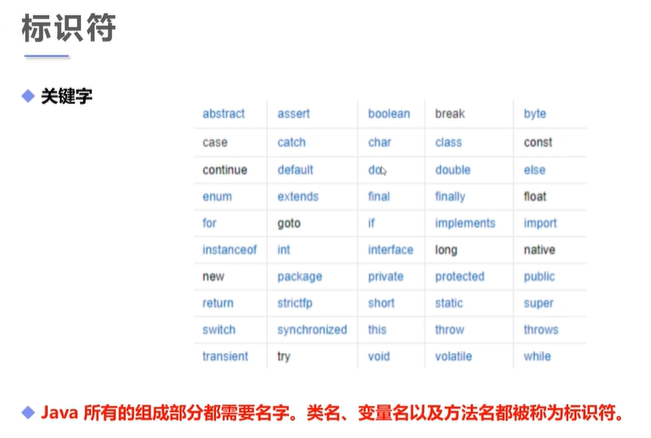

3.数据类型
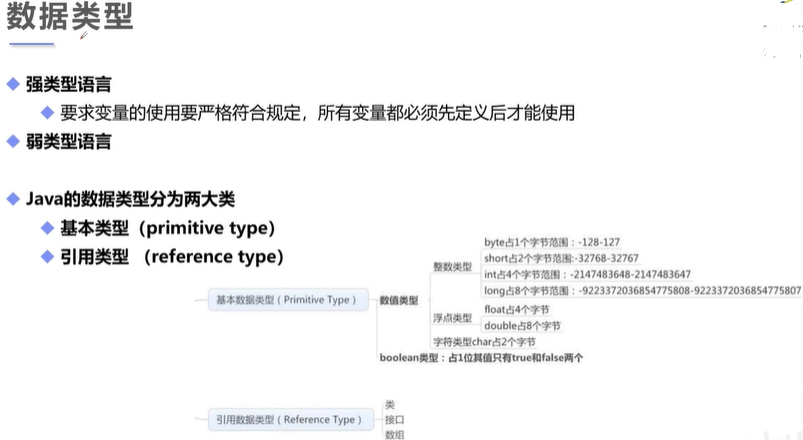
public class helloworld{ public static void main(String[] args) { String a = "hello"; int mun = 10; System.out.print(a); System.out.print(mun); } }
public class helloworld{ public static void main(String[] args) { //八大基础数据类型 //整数 int num1 = 10; //最常用 byte num2 = 20; short num3 = 30; long num4 = 30L; // Long类型要在数字后面加L //小数:浮点数 float num5 = 50.1F;// float类型要在数字后面加F double num6 = 3.141592654; //字符 char name = 'A'; //字符串,String 不是关键字,是类 // String name = "xiaodi"; //布尔值:是非 boolean flag = true; boolean flag1 = false; } }
public class helloworld{ public static void main(String[] args) { //整数拓展: 进制 二进制0b 十进制 八进制0 十六进制0x int i1 = 10; int i2 = 010; //八进制0 int i3 = 0x10; //十六进制0x 0~9 A~F System.out.println(i1); System.out.println(i2); System.out.println(i3); } }
public class helloworld { public static void main(String[] args) { //浮点数拓展 //银行业务数字,不用浮点的float和double表示,一般用:BigDecimal 数学工具类 //场景1 float f = 0.1f; double d = 1.0/10; //广义理解以上两个变量,算出来都是0.1,但是代码中,是不等于的 System.out.println(f==d); //输出结果为:false System.out.println(f); //0.1 System.out.println(d);//0.1 //场景2 float d1 = 32323232323232f; float d2 = d1+1; System.out.println(d1==d2);//广义理解以上两个变量不一样,输出结果预期是false,实际运行结果为true // 因为浮点数取数是有限的,结果只是接近,大约 } }
public class helloworld { public static void main(String[] args) { //字符拓展 char c1 = 'a'; char c2 = '中'; System.out.println(c1); //实际输出结果 a System.out.println(c2); //实际输出结果 中 System.out.println((int)c1);//强制转换可以把字符转换为数字: 实际输出结果 97 System.out.println((int)c2); //强制转换为数字后 实际输出结果 20013 //以上4个输出代表:所有的字符本质上还是数字,通过Unicode编码 来编码的。 //有对应的编码:类似以上:a=97 中=20013 输出时会去查Unicode编码的表 //Unicode编码的表示方式 U0000 UFFFF char c3 = '\u0061'; //\u 转义 System.out.println(c3); //输出结果为:a //C3的输出结果,充分说明了 //Unicode(统一码)其实相当于一本很厚的字典,里面储存了世界上所有语言的字符,使用Unicode码点唯一地对应一个字符。 //2,转义字符 // \t 制表符(空格) // \n 换行 } }
public class helloworld { public static void main(String[] args) { //布尔值扩展 boolean flag = true; if (flag==true){} //新手写法 if (flag){} //老手写法,默认为真 //精简易读 } }
4.类型转换
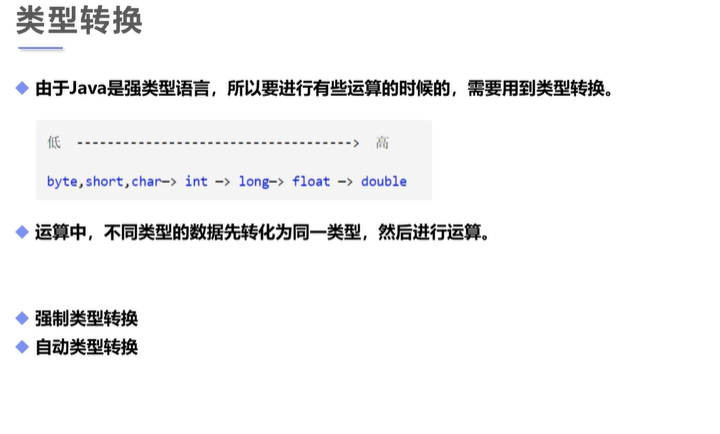
1、其中byte、short、int、long都是表示整数的,只不过他们的取值范围不一样
byte的取值范围为-128~127,占用1个字节(-2的7次方到2的7次方-1)
short的取值范围为-32768~32767,占用2个字节(-2的15次方到2的15次方-1)
int的取值范围为(-2147483648~2147483647),占用4个字节(-2的31次方到2的31次方-1)
long的取值范围为(-9223372036854774808~9223372036854774807),占用8个字节(-2的63次方到2的63次方-1)。
2、浮点:float、double
float在储存大型浮点数组的时候可节省内存空间;浮点数的默认类型为double类型;浮点数不能用来表示精确的值,
3、字符类型 char
char类型是一个单一的16位Unicode字符;(2字节)
最小值是’\u0000’(即为0);
最大值是’\uffff’(即为65,535); 2的16次方 -1 (2^16 -1)
public class helloworld { public static void main(String[] args) { //类型转换 /** * 1,不能对布尔值进行转换 * 2,不能把对象类型转换为不相关的类型 * 3,在把高容量转换到低容量的时候需要强制转换,低转高不需要 * 4,转换的时候可能存在内存溢出,或者精度问题 */ //强制转换 格式:(类型)+变量名 //自动转换 低-高 //场景一,转换时内存溢出 int i = 128; byte b = (byte)i; //这里如果写成 byte b = i; 会报错,b是byte类型,但是i是int类型。所以强制转换的格式很重要。 System.out.println(i); //输出结果 128 System.out.println(b); //输出结果 -128 //造成以上输出结果的原因是,byte最大数是127,128时,就造成了内存溢出,所以输出结果会是负数 //场景二:数据高到低需要强制转换, 低到高,可以自动转换 int i2 = 128; double b2 = i2; System.out.println(i2); //输出结果 128 System.out.println(b2); //输出结果 128.0 //场景三,精度丢失问题。 System.out.println((int)23.7); //输出结果: 23 丢失了小数点后数据 System.out.println((int)-45.89F); //输出结果: -45 丢失了小数点后数据 //场景四,字符转数字 char c = 'a'; int d = c+1; //低转高,自动转换 System.out.println(c); //输出结果:a System.out.println(d); //输出结果:98 System.out.println((char)d); //输出结果:b 说明在Unicode编码中,98 就是b 编码-1,97就是a char c4 = '\u0098'; System.out.println(c4); //验证一下上面的结果,输出结果为b } }
public class helloworld { public static void main(String[] args) { //操作比较大的数的时候,注意溢出问题 //场景1:Jdk7新特性数字之间可以下划线_分割,不影响输出结果 int money = 10_0000_0000; System.out.println(money); //输出结果,1000000000 //场景2: int years = 20; int total = money*years; System.out.println(total); //实际输出结果:-1474836480,期待结果200_0000_0000 这样就内存溢出了 long total2 = money*years; System.out.println(total2); //这样使用long,也不行,因为两个变量是int,就是默认int,在转换之前就已经内存溢出了 long total3 = money*((long)years); System.out.println(total3); //实际输出结果,20000000000,这样写就不会存在内存溢出问题了。 //PS:int数据范围-2147483648-2147483647 最大21亿,以上变量计算结果为200亿,所以内存溢出; } }
5.变量
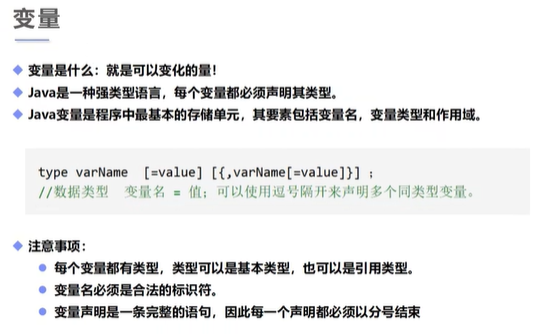

public class helloworld { public static void main(String[] args) { //变量 //int a,b,c // int a=1,b=2,c=3;不建议这么写,要注意程序的可读性 int a=1; int b=2; int c=3; //尽量采用这种分行来写 int属于基本类型变量 String name = "xiaodi"; //String属于引用类型变量 char X = "xiao"; double pi = 3.14; } }
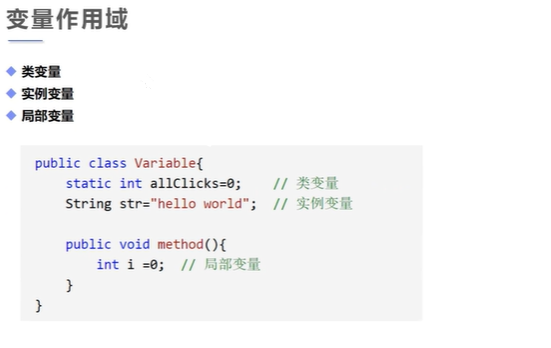
//变量作用域-局部变量 public class helloworld { //helloworld 就是类,类名 //类里面除了像main的方法,还能定义属性 属性可以理解为就是一个变量 public static void main(String[] args) { //main方法 默认的主程序方法 //局部变量:局部变量是在方法或者语句块里边的, // 在两个{}之间的,有效期从第一个{开始,到}结束。 //而且必须声明和初始化值 //int i; //而且必须声明和初始化值 int i=10; // i这个变量只能在这一个方法里边使用,其他方法不能用。 System.out.println(i); } //类里面除了像main的方法,还能写其他方法,比如于下方add方法 public void add(){ } }
//变量作用域-实例变量 public class helloworld { //实例变量,不在方法里边,在类里边,从属于对象的,(从属于helloworld这个类) String name; //实例变量可以不初始化,直接用 int age; public static void main(String[] args) { helloworld helloworld = new helloworld(); //变量类型 变量名 = 值(变量就是自己helloworld) System.out.println(helloworld.name); //输出结果 null 因为上面没有初始化值,而在实例变量中,如未初始化值,就会变成这个类型的输出默认值 System.out.println(helloworld.age); //输出结果 0 // 整数 0 小数0.0 布尔值fales // 除了基本类型,其他的都是null 包括String } }
//变量作用域-类变量-static public class helloworld { static double salary = 2500; //只要加了关键字static,就是从属于类的变量,可以直接使用 public static void main(String[] args) { System.out.println(salary); } }
6.常量

//常量-final public class helloworld { static final double PI = 3.14; //static 和final 位置可以不区分前后 ,他俩都是修饰符,修饰符不存在先后顺序,public也是 //常量也属于类变量,所以需要加static //项目中一些定死的值,就可以用常量,常量定义后,就不能变。静态常量 public static void main(String[] args) { System.out.println(PI); } }




